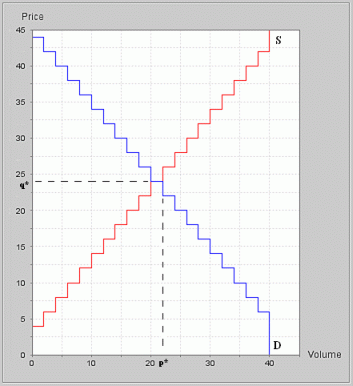|
|
|
Competitive market experiments are a valuable demonstration of one of
the key results from the microeconomics curriculum. In a market with
many sellers and many buyers, the competitive pressures among sellers
and among buyers lead to a stable market price and to an efficient
allocation of the commodity.
|
|
In the competitive market model, there are many buyers whose aggregate
demand is qD = D(p). There are also many sellers whose aggregate supply is qS = S(p). In the most common case,
demand decreases as price increases and supply increases as the price
increases. Under these assumptions, if the demand exceeds the supply
when the price is zero, then there is a unique price p* where the
demand and supply are equal. The equation for this is that
D(p*) = S(p*).
|

|
|
Figure 1: Competitive market experiment
|
|
Figure 1 shows the supply (S), the demand (D), the competitive
equilibrium price p*, and the competitive equilibrium quantity of
trade q* for a sample market. MarketLink experiments that test the
competitive equilibrium predictions have been prepared for both the
double auction and the posted offer auction.
To add the configuration for the double auction competitive market
to your profile, click on the button below.
|
|
To add the configuration for the posted offer competitive market to
your profile, click on the button below.
|
| |